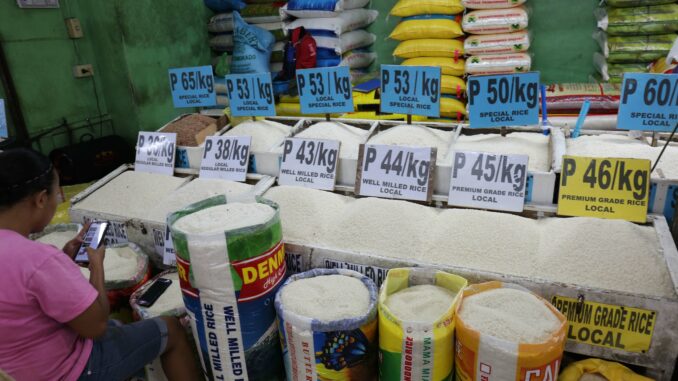
Expect a food shortage in the coming years.
Production of major agricultural products is down.
Rice prices have collapsed, thanks to unabated importations. Because rice prices have collapsed, it is now hugely unprofitable for Filipino rice farmers to produce rice. Farmers have stopped planting rice.
The price of palay in the farm has dropped to as slow as P8 per kilo, according to some experts. That is palay. Every 100 kilos of palay convert into 63 kilos of rice. So if palay price is P8 per kilo, that translates into P11 rice price. To convert that into retail price, double it, so P22 per kilo.
Cost of palay production is P17 per kilo or P24 in rice terms. Why produce palay when you lose half of what already is your very meager capital?
Rice is very important to the economy. It is 15 points of the 100 points of the Consumer Price Index. In general, food is as much as 55 points of the CPI. You increase the price of rice, you accelerate inflation as it did in September-October 2018 when inflation rose to its highest in 11 years because of a rice shortage.
This year, the collapse of rice prices at the farm gate should have benefitted rice consumers, you and me. Rice should be as low as P25 per kilo, retail. But no. Rice prices remain very high. At the San Juan public market yesterday (August 8), the lowest price for rice was P32. The highest: above P50 a kilo. Who is making money? The traders.
Before the so-called Rice Tariffication Law, the farm gate price of rice was as high as P30 per kilo. This, in turn, was sold by rice traders, who are a small circle of racketeers, to as high as P50 per kilo. Rice tariffication means anyone can import rice because there is no more quota limit, as long as one pays the tariff, which is about 35%.
Imported rice is only half of the price of locally produced rice. So right away, you have a 100% profit margin. You pay 35% as tariff, you still have 65% gross margin. You pay corrupt customs and other government people 20%, you still have 45% margin. You allow the retailer 20% margin and you end up with 25% net profit. That is assuming everything is legal and is in order.
But what if you smuggle the rice? Then you save on the 35% tariff. Add that to your 25% margin and you are good at 60% gross profit. Because of greed, everybody now wants to be a rice importer and trader. Damn the poor farmer. Government will take care of him.
But the government cannot take care of the rice farmer – yet. The tariffication law is supposed to provide a P10 billion annual subsidy to rice farmers. The yearly P10 billion Rice Competitiveness Enhancement Fund (RCEF) from rice tariff collections is supposed to be spent as follows: P5 billion for mechanization; P3 billion for high-yielding hybrid rice seeds, and research; P1 billion for training of farmers; and P1 billion for farm credit.
Right now, nobody knows what to do. What does mechanization mean? Harvesters, threshers, jeepneys, trucks, tricycles or carabaos? These are all machines used in the rural areas. Is P3 billion enough for hybrid rice seeds? Hybrid seed is very expensive and needs lots of water or irrigation (free under Duterte if you are in a NIA area), lots of fertilizer (very expensive), and lots of tender loving care (farmers are loving, but only if you are a human being and lovely). Is P1 billion farm credit enough?
The state-owned Land Bank, now the Philippines’ third largest bank and is 56 years old, is now more of a commercial bank than a bank for agriculture. President Duterte wants it shut down. Indeed, if Land Bank had been financing agriculture, agriculture wouldn’t do so badly.
In the first half of 2019, agricultural production as a component of the Gross Domestic Product or GDP, was up only .24%.
Per new Agriculture Secretary William Dar, the country’s agriculture sector grew by a measly 0.56% growth in 2018 or below the government’s target of 4%. In 2017, the sector registered a growth of 3.95%, -1.41% in 2016, 0.11% in 2015, and 1.83% in 2014.
In the past 30 years, agricultural growth has averaged 0.2%. So 30 years times 0.2 is 6%. In the past 30 years, the Philippine population rose from 62 million in 1990 to 106 million today, an increase of 44 million more mouths to feed, or up 70%. 70 minus 6, that’s an implied food shortage of 64%. Filipinos missed eating 64% of what they should have eaten in 30 years. We should have eaten 100 kilos of food but ended up eating only 36 kilos. Because of food shortage. How sad.
The result is malnutrition. Malnutrition affects the brain. It makes you stupid. No wonder Filipinos keep electing the wrong leaders. Out of stupidity. Because those leaders think Filipinos are stupid, they become corrupt, incompetent, or both. Because our people are stupid and our leaders are corrupt, incompetent, or both, the Philippines has not solved its poverty in the last 30 years.
Thirty years ago, there were already 25 million very poor Filipinos. Today, we still have 25 million very poor Filipinos. Normally, to remedy that you need a revolution. Since we don’t have the budget for firearms and most if not all the generals are with Duterte, people cannot stage a revolution.
The solution then: A revolution in agriculture. Can Secretary Dar do it?
— Tony Lopez
